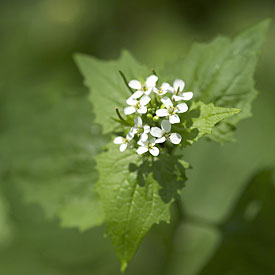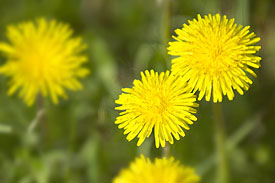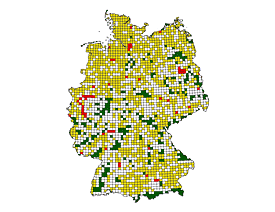Press release, September 18, 2008
Similarity of urban flora
New study shows that plants in towns and cities are more closely related than those in the countryside
Halle/Saale. More plant species grow in German towns and cities than in the countryside, but those in towns and cities are more closely related and are often functionally similar. This makes urban ecosystems more susceptible to environmental impacts. This is the finding of ecologists at the Helmholtz Centre for Environmental Research (UFZ) who evaluated 14 million entries in the German national FLORKART database, which has been built up by several thousand volunteers over the past few years. They claim that because of the altered environmental conditions, nature conservation needs to look not only at conserving as many species as possible, but also at other aspects of species diversity. Writing in the October issue of Ecology Letters, the researchers say that since urbanisation is already far advanced and will continue to advance in future, we need to develop strategies to protect species diversity even within towns and cities.

The Garlic mustard (Alliaria petiolata) belongs to the Mustard family, Brassicaceae.
Brassicaceae are often found in cities.
Photo: André Künzelmann/UFZ
download as jpg (1.4 MB)
Terms of use

The Dandilion (Taraxacum spec.) is quite common in cities.
Photo: André Künzelmann/UFZ
download as jpg (0.8 MB)
Terms of use

For their study, the researchers laid a grid of cells, each around 12 kilometres wide, over
Germany and characterised the cells in terms of land use. 59 cells were classified as urban landscape (red), 1365 as
agricultural (yellow) and 312 as forest or near-natural landscapes (green).
Source: UFZ
The urbanisation of the world is increasing rapidly. More than half of the world’s population lives in towns and cities. In Europe the figure is as high as 70 per cent. The fact that there is a higher number of species in towns and cities than in the surrounding countryside is due to a number of different reasons: many towns and cities developed in geologically and structurally diverse landscapes, so are naturally rich in species; the towns and cities themselves have very diverse structures, temperatures are higher than in the surrounding countryside, and alien species are often introduced into towns and cities. However, although towns and cities harbour more species than the surrounding countryside, in terms of conserving biological diversity it is not just the number of species that matters, but also their relatedness (i.e. phylogenetic diversity). Every species is a carrier of inherited information that determines e.g. pollination method and leaf structure. The greater the phylogenetic diversity of a community, the greater the probability that it will contain species with different traits. The traits and, consequently, the phylogenetic diversity, are therefore the tools that enable plant communities to respond to different environmental events. Without knowledge about traits and relatedness (phylogenetics) our understanding of how communities develop and how they deal with altered environmental conditions will remain incomplete.
For their study, the researchers laid a grid of cells, each around 12 kilometres wide, over Germany and characterised the cells in terms of land use. 59 cells were classified as urban landscape, 1365 as agricultural and 312 as forest or near-natural landscapes. "Our findings lead us to believe that different environmental filters operate in urban areas and in rural areas," explains Sonja Knapp of the UFZ. The loss of phylogenetic information reduces a community’s ability to respond to environmental changes and could in the long term have a negative impact on the functions of urban ecosystems.
The largest ever conference of ecologists from all over Europe was taking place in Leipzig from 15 to 19 September 2008.
Over 1000 participants from more than 30 countries have registered for EURECO-GFOE 2008. The conference is a joint
meeting of the European Ecological Federation (EEF) and the Gesellschaft für Ökologie (GfÖ) and is being organised at the
Congress Center Leipzig by the Helmholtz Centre for Environmental Research (UFZ) and the Universities of Halle-Wittenberg
and Leipzig. The EEF is the umbrella organisation of the national ecological associations in Europe. Over 8000
ecologists belong to its member associations. The GfÖ is the ecological society of Germany, Austria and Switzerland.
Tilo Arnhold
More information:
Sonja Knapp, Dr. Ingolf Kühn
Helmholtz Centre for Environmental Research (UFZ)
Phone +49 345 558-5308, -5311
Sonja Knapp
Dr. Ingolf Kühn
or
Helmholtz Centre for Environmental Research (UFZ)
Press release
Tilo Arnhold
Phone +49 (0)341 235 1269
presse@ufz.de
Publication
Sonja Knapp, Ingolf Kühn, Oliver Schweiger, Stefan Klotz:
Challenging urban species diversity: contrasting phylogenetic patterns across plant functional groups in Germany.
Ecology Letters
DOI: 10.1111/j.1461-0248.2008.01217.x
http://www3.interscience.wiley.com/journal/120749881/abstract
Die Untersuchungen wurden teilweise vom Virtuellen Institut für Makroökologie gefördert.
Links:
FloraWeb - Information portal of the Federal Agency of Conservation (BfN):
http://www.floraweb.de
You can read more about biological invasions and other issues concerning biodiversity in a special edition of the UFZ newsletter
for the 9th Meeting of the Conference of the Parties to the Convention on Biological Diversity (COP9), that was from 19 to 30 May in
Bonn.
www.ufz.de/index.php?en=10690
At the Helmholtz Centre for Environmental Research (UFZ) scientists research the causes and consequences of far-reaching
environmental changes. They study water resources, biological diversity, the consequences of climate change and adaptation
possibilities, environmental and biotechnologies, bio energy, the behaviour of chemicals in the environment and their effect on
health, as well as modelling and social science issues. Their guiding research principle is supporting the sustainable use of
natural resources and helping to secure these basic requirements of life over the long term under the influence of global change.
The UFZ employs 900 people at its sites in Leipzig, Halle and Magdeburg. It is funded by the German government and by the states of
Saxony and Saxony-Anhalt.
The Helmholtz Association helps solve major, pressing challenges facing society, science and the economy with top scientific
achievements in six research areas: Energy, Earth and Environment, Health, Key Technologies, Structure of Matter, Transport and Space.
With 25,700 employees in 15 research centres and an annual budget of around EUR 2.3 billion, the Helmholtz Association is Germany’s
largest scientific organisation. Its work follows in the tradition of the great natural scientist Hermann von Helmholtz (1821-1894).
